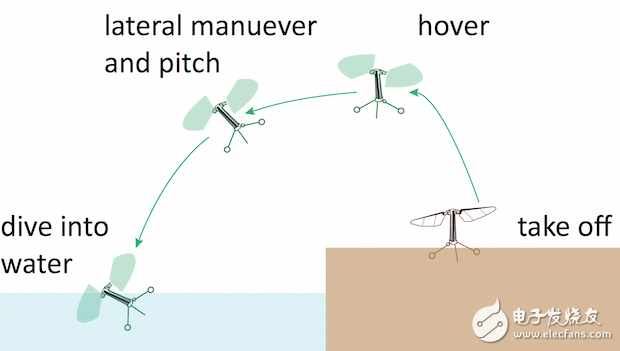By Evan Ackerman30 Sep 2015 15:40 GMTHarvard's Robot Bee Is Now Also a Submarine
Image: Wyss Institute/Harvard University Gone swimmin'.
For the last several years, Harvard has been developing a robot bee. They’ve done some impressive work: their sub-paper-clip-sized, 100-milligram flapping-wing micro aerial vehicle is fully controllable down to a stable autonomous hover. It’s still tethered for power, and there’s no onboard autonomous control, but the robot flaps its wings and flies like an insect, which is awesome.
Tiny robotic bugs have lots of potential for search and rescue, surveillance, and exploration, but what’s been all the rage recently is adaptive multi-modal robotics: robots that can creatively handle a combination of terrains, making them much more versatile. With some exceptions, robots are usually pretty bad at this, and with some exceptions, humans and animals are too. There are ground robots that can handle water, and a few flying robots that aren’t totally helpless on the ground, but so far, we haven’t seen much in the way of flying robots that are good swimmers.
Yesterday at IROS, Harvard researchers presented a paper describing how they managed to get their robotic bee to swim, which I’m pretty sure is not a thing that even real bees are known for doing. With no hardware modifications at all, Harvard’s RoboBee can fly through the air, crash land in the water, and turn into a little submarine. You know what that means: nowhere is safe from robot bees.
Photo:Wyss Institute/Harvard UniversityHarvard’s RoboBee.
Things to keep in mind about these videos: RoboBee is small enough to sit on the tip of your finger, and light enough that you’d barely feel it if it was. When it flies (or swims), it’s doing so under full control: a motion capture system tracks its position, and sends trajectory commands to the robot. This works in both air and water, and RoboBee’s method of entry (a pitch over, dive, crash, and sink) is deliberate. Also, the hovering at the beginning of the first video belowlooks a little bit wonky, but that’s because RoboBee still has some water on its wings from previous tests (a more stable hover is shown in that same video, after the diving sequence, and the second video belowhas more detailsabout the experiments).
The key realization here is that swimming is actually a lot like flying: in both cases, you’re trying to propel yourself through a fluid by moving a wing (or fin) back and forth. To fly (and particularly to hover) you need to do this very quickly, but to swim, it’s a much more relaxed motion. It’s fundamentally the samemotion, though, and you can achieve it with the same basic hardware. In the case of RoboBee, to fly in air it flaps its wings at 120 Hz, while to swim in water it flaps its wings at just 9 Hz. Otherwise, three axis torque control is very similar, meaning that the robot can be steered around in the water, too.

One unique problem that RoboBee has with the water entry is that it’s so small that the surface tension of the water is enough to keep it from submerging. This is part of the reason that it has to crash land in water[right] (it alsoneeds to have its wings treated with a surfactant to help it sink). A fully loaded RoboBee (with a battery on board) might be heavy enough to avoid this problem, but at this point, it’s still an issue. Also still an issue is the whole water-air transition, which seems like it’s significantly more difficult than going from air to water, but we’ve been assured that the researchers will be tackling this in future work.
“Hybrid Aerial and Aquatic Locomotion in an At-Scale Robotic Insect,” by Yufeng Chen, E. Farrell Helbling, Nick Gravish, Kevin Ma, and Robert J. Wood from the Wyss Institute for Biologically Inspired Engineering at Harvard University was presented this week at IROS 2015 in Hamburg, Germany.
翻譯僅供參考
哈佛大學的機器蜜蜂現在還能潛水 harvard機器人蜜蜂現在也是一個submarine
圖像:威斯研究所/哈佛大學去游泳和# 39;。在過去的幾年里,哈佛一直在開發一個機器人蜜蜂。他們都做了一些令人印象深刻的工作;其子回形針大小,100毫克的撲翼微型飛行器是完全可控的下降到一個穩定的自主懸停。我仍然拴權力;有’沒有星上自主控制,但機器人拍打著翅膀像昆蟲,這是真棒。
微型機器人的錯誤有很多潛在的搜索和救援,監控,和探索,但與rsquo;的風靡最近的自適應多模態機器人:機器人能創造性地處理相結合的地形,使它們更加靈活。在一些例外情況下,機器人通常是很不好的,并且有一些例外,人類和動物都是如此。有地面機器人可以處理水,和一些飛行機器人是&rsquo;不完全無助于地面,但到目前為止,我們還沒有看到太多的&ldquo;飛行機器人是好的游泳方式。;< / P >
昨天在IROS,哈佛研究人員發表了一篇論文,描述他們如何設法得到他們的機器人蜜蜂游泳,我在其中;肯定不是一件真正的蜜蜂被稱為做。沒有在所有的硬件修改,哈佛&rsquo;的robobee可以在空中飛行,在水上迫降,而變成了一個小潛艇。你知道這意味著什么:沒有安全從機器人蜜蜂。
photo:;Wyss研究所/哈佛universityharvard &rsquo;的robobee。<記住這些視頻P的事情:robobee是足夠小,坐在你的指尖,光照充足,你我幾乎感覺不到它;如果它是D。當它飛行(或游泳),真的這樣做;完全的控制之下:運動捕捉系統跟蹤其位置,并發送指令到機器人軌跡。這部作品在空氣和水,和robobee &rsquo;入門的方法(一個音調,跳水,崩盤,沉)是故意的。同時,徘徊在下面?第一視頻的開始;看起來有點不靠譜,但那是因為robobee;還有一些水在它的翅膀從以前的測試(一個更穩定的懸停顯示在相同的視頻,在潛水的序列,和下面的第二個視頻?;有更多的細節?;關于實驗)。
實現的關鍵是,游泳其實是很多像飛一樣:在這兩種情況下,你正在試圖推動自己;通過流體的運動機翼(或尾翼)來回。飛(特別是懸停)你需要很快地做到這一點,但游泳,這是一個更寬松的運動。這是從根本上相同;;運動,雖然,你可以用相同的基本硬件實現。在robobee案例,飛在空氣中扇動的翅膀在120赫茲,而在水中游動,它扇動的翅膀在9赫茲。否則,三軸轉矩控制是非常相似的,這意味著機器人可以把周圍的水,太。

一個獨特的問題,robobee與入水是&rsquo;太小,水的表面張力,足以讓它淹沒。這是一部分的原因,它已經崩潰的土地,水,[權利](它也和需要有它的翅膀處理與表面活性劑,以幫助它下沉)。一輛滿載robobee(船上有一個電池)可能足以避免這個問題,但在這一點上,這仍然是一個問題。還一個問題是整個氣水過渡,這似乎&rsquo;的比從空氣水更困難,但是我們一直放心;研究人員將解決這個在以后的工作中。
-
機器人
+關注
關注
211文章
28501瀏覽量
207484
發布評論請先 登錄
相關推薦
【「具身智能機器人系統」閱讀體驗】2.具身智能機器人的基礎模塊
【「具身智能機器人系統」閱讀體驗】2.具身智能機器人大模型
【「具身智能機器人系統」閱讀體驗】1.初步理解具身智能
【「具身智能機器人系統」閱讀體驗】+初品的體驗
《具身智能機器人系統》第1-6章閱讀心得之具身智能機器人系統背景知識與基礎模塊
醫療機器人有哪些_醫療機器人有哪些應用
開源項目!用ESP32做一個可愛的無用機器人
開源項目!用ESP32做一個可愛的無用機器人
柔性機器人與剛性機器人區別與聯系

Al大模型機器人
基于FPGA EtherCAT的六自由度機器人視覺伺服控制設計
其利天下技術·搭載無刷電機的掃地機器人的前景如何?
「喜報」邁步機器人榮獲機器人應用典型案例獎





 機器人這樣牛?哈佛大學的機器蜜蜂還能潛水
機器人這樣牛?哈佛大學的機器蜜蜂還能潛水










評論